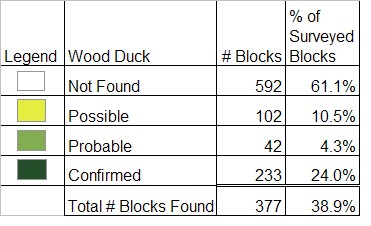Breeding Bird Atlases (BBA)
Find a Bird - BBA1
Breeding Bird Atlas 1 Species Accounts
Wood Duck
Aix sponsa
Egg Dates
late March to mid-July
Number of Broods
one; may re-lay if first attempt fails.

By the turn of the last century, the colorful Wood Duck was nearly extirpated from Massachusetts as well as throughout most of the Northeast. As settlers cut the forests to clear land for agriculture, the Wood Duck lost the cavity trees it needed for nesting. Popular as table fare, the duck was commercially exploited as well. Populations began to recover after the bird was given complete protection in 1918, and nesting habitat was restored as New England farms reverted to forest. A limiting factor was the paucity of trees old enough to develop sizable nesting cavities, but a massive statewide nest box program in the early 1950s helped to restore the Wood Duck population to previous levels.
However, the extensive use of DDT and other pesticides about this time destroyed populations of insects required by young ducklings, and the population began another decline that lasted until the early 1970s. The combination of a ban on DDT, the maturation of the forest, an increasing Beaver population whose activities created favorable breeding habitat, and carefully controlled hunting seasons has allowed the Wood Duck once again to become a common nester. Populations are densest in the eastern third of the state, excluding Cape Cod and the Islands, where suitable cavity trees are still uncommon.
While a few Wood Ducks overwinter, most birds arrive in Massachusetts in early to mid-March, having left their winter quarters in late February. They can be found on Beaver ponds and river floodplains, along slow-moving streams, and in deep marshes throughout the state. Secretive ducks, they prefer the cover of Buttonbush and emergent vegetation and are not often seen on open water. Males have a distinct whistling note, while the females give a characteristic squealing wee-ee-k.
Strictly a cavity nester, the Wood Duck will utilize both living trees and standing snags, requiring at least a 3.5-inch opening and a cavity about 9 inches in diameter. Females bring in no nesting material but rely on the rotted pulp of the cavity, later adding down from their breasts when egg laying advances. They adapt readily to nest boxes supplied with shavings.
 Nesting commences the last week of March in southeastern Massachusetts and about the first week of April in the rest of the state. Yearlings begin nests about a month after adult birds, and many do not breed the first year, perhaps because of the scarcity of cavities. Clutch size ranges from seven to fifteen eggs, averaging ten for yearlings and twelve for adults. Larger clutches are the result of other hens laying eggs in a nest, and it is not unusual for a hen to hatch a brood of twenty-four or more ducklings. At times, hens hatch a combination of their own young and those of the Hooded Merganser (see account for that species).
Nesting commences the last week of March in southeastern Massachusetts and about the first week of April in the rest of the state. Yearlings begin nests about a month after adult birds, and many do not breed the first year, perhaps because of the scarcity of cavities. Clutch size ranges from seven to fifteen eggs, averaging ten for yearlings and twelve for adults. Larger clutches are the result of other hens laying eggs in a nest, and it is not unusual for a hen to hatch a brood of twenty-four or more ducklings. At times, hens hatch a combination of their own young and those of the Hooded Merganser (see account for that species).
Eggs hatch in 28 to 32 days, depending upon the clutch size and ambient temperatures. Three main hatch times in Massachusetts are May 10 to May 31 (for adult hens), June 1 to June 21 (for yearling hens), and June 22 to July 19 (for renesters). Ducklings leave the nest 24 to 36 hours after hatching, jumping out of the entrance in response to their mother’s call and sometimes dropping 40 feet or more without mishap. The hen leads the ducklings to water where they feed on insects, gradually switching to plant foods as they feather out and protein requirements diminish. The young fledge in about 60 days. In Massachusetts, the average brood size at hatching was 12.5 ducklings and at flight stage was 5.8 ducklings.
Drakes desert their mates after the females begin spending most of the day incubating. The males undergo an eclipse molt, assuming the drab colors of the female while they replace their wing feathers. They molt a second time to regain their breeding plumage. Some drakes begin leaving the area in August, but most Wood Ducks remain and begin gathering nightly at roosts in September and early October. Often small groups of birds can be observed flying in at dusk to wooded swamps until several hundred have arrived. With the onset of persistent freezing weather (which is usually coincident with the start of the hunting season), Wood Ducks depart for the south, where they winter in wooded swamps from North Carolina to northern Florida. Massachusetts Wood Ducks appear to winter primarily in the Carolinas.
Map Legend and Data Summary
Atlas 1 data collected from 1975-1979


Note: fairly common and widespread in wetlands throughout the state; status correlated with availability of nest boxes
H. W. Heusmann



